ultimately pay. The goal of this PIMBY is to provide an informed and
balanced overview of the project and its implications for energy consumers, taxpayers, the environment and the Tasmanian community.
Our aim is to contribute to the debate about Marinus and Tasmania’s energy system. With an eye to the future, we outline strategies and policies that will minimise the environmental and financial risks while maximising the long-term consumer and community benefits.
What is Marinus Link?
Marinus Link Stage 1 will be a 345 kilometre, 750 megawatt high-voltage interconnector and fibre-optic data cable between Heybridge near Burnie, and Hazelwood in Victoria. Together with the existing Basslink 500MW interconnector, total transmission capacity between Tasmania and the mainland grid will reach 1250MW – enough to meet around 70% of
Tasmania’s peak demand.
From a Tasmanian perspective, Marinus Link is related to the
$1.14 billion North West Transmission Development (NWTD), which will upgrade the grid between Heybridge and the rest of the state. This part of the project will be managed by TasNetworks.
At its core, Marinus is about enabling a two-way flow of electricity between Victoria and Tasmania to get renewable energy where it’s needed most. This is especially important as we transition to an electricity market in which the generation of wind and solar power are cheap and plentiful during the day and over summer, but power becomes expensive during the evening peak and over winter. With aging coal-fired power stations closing over the next decade, Tasmania’s hydro power can help fill this energy gap and provide much needed backup for the National Energy Market (NEM).
From a Tasmanian perspective, there’s growing recognition that our existing hydro-dominated electricity system is efficient but finely balanced. As electrification accelerates across the economy, maintaining energy security and flexibility will require new interconnection and storage solutions.

Adapted from:
Marinus Link
Construction of Marinus Link and the associated transmission and converter stations are scheduled to begin in 2026, with Stage 1 completed by 2030. Stage 2, if confirmed, will see the addition of a
second 750MW cable.
The Marinus Link project has evolved considerably since it was
first proposed in 2017. Initially, both cables were to be constructed at the same time, at a
cost of between $1.3 to $3.1 billion. But like most transmission projects worldwide, the costs have increased significantly during the development and commissioning phase. Given these escalating project costs, the decision was made in
June 2023 to split the project into 2 stages. Currently, Stage 1 is now expected to be
$3.89 billion for Marinus Link, and then $1.14 billion for the
associated NWTD.
In 2024, Marinus Link became its own company –
Marinus Link Pty Ltd (MLPL) – jointly owned by the Commonwealth (49%), Victorian (33.3%) and Tasmanian (17.7%) Governments. However,
TasNetworks retains responsibility for the
NWTD.
Importantly, the NWTD is to be funded solely by Tasmanian consumers, although it now benefits from a
$346 million Commonwealth grant and concessional finance. Ideally, this funding would help reduce project costs and, in turn, electricity prices.
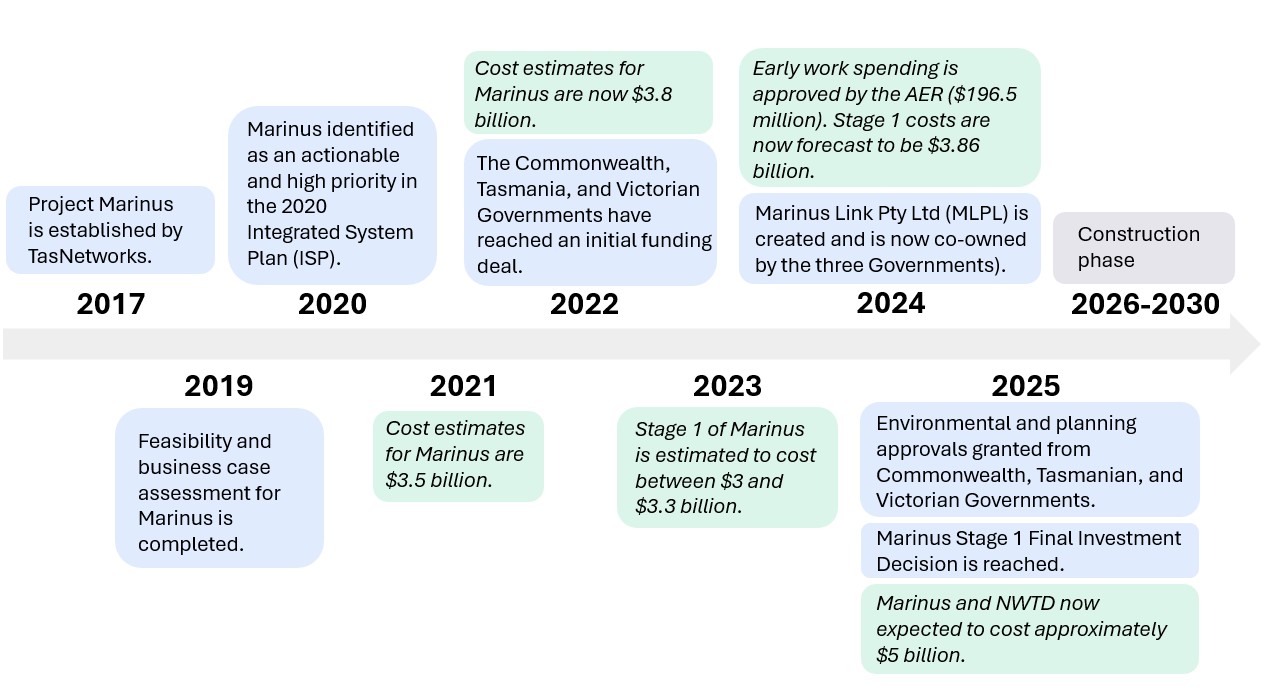
The National Case for Marinus Link
To meet national and international climate targets, aging coal-fired power stations will be closed in Australia by the mid-2030s. Renewable generation from solar and wind farms can fill this gap – but will require new transmission infrastructure and storage capacity to ensure reliable, year-round supply.
AEMO estimates that to keep the lights on during this transition will require at least $142 billion investment, paid for through a mix of consumer energy bills and concessional finance provided by the
Commonwealth Government.
To coordinate this, AEMO maintains the
Integrated System Plan (ISP) – a roadmap to guide investment in electricity generation and transmission projects and ensure reliable and affordable electricity across states. Marinus Link has been
identified as an actionable project since 2020.
Marinus may be an important project for Australia’s future energy system, but the $5 billion question is if Marinus is a cost-effective investment and whether Tasmanian consumers can afford it? According to
cost-benefit analysis conducted using the Australian Energy Regulator guidelines (known as the RIT-T), Stage 1 of Marinus Link is expected to deliver a net market benefit of between
$3 and $3.6 billion (2023 dollars). In other words, more benefit than cost. But as we will point out later, exactly who pays and who gains remains open to debate.
The National Energy Market
The
National Energy Market (or NEM) is a wholesale electricity market and network that operates in New South Wales, the Australian Capital Territory, Queensland, South Australia, Victoria, and Tasmania. It
began in 1998, but
Tasmania was not connected until 2005, in anticipation of the Basslink being constructed. The NEM is geographically
one of the largest interconnected power systems in the world, and serves over 10.7 million customers.
Who pays and will Marinus deliver lower power prices?
Marinus will help ensure the stability and reliability of the NEM during Australia’s energy transition and beyond – but it comes with a hefty price tag. So, who pays for it, and will it actually lower power bills? There are five key questions to answer here.
1. Who owns Marinus?Much was made of the
Tasmanian Government’s decision to reduce its ownership stake in Marinus Link. Tasmania’s smaller 17.7% stake (worth $103.5 million) limits our financial exposure but has no impact on consumer energy prices. State-owned TasNetworks will continue to own and operate the NWTD. Significantly, under NEM rules, consumers pay for regulated transmission projects through their power bills, no matter who owns them.
2. How much will consumers pay?The Australian Energy Regulator (AER) decides how much transmission companies can recover from customers through something called a
Revenue Determination. At present, the forecast capital cost of Marinus Link Stage 1 is $3.9 billion. That figure, however, isn’t a hard cap at $3.9 billion. If costs rise, the AER can allow higher recovery so long as the spending is ‘efficient and prudent’.
Consumers can take some comfort that major suppliers for Marinus Link have been contracted, but if other
similar transmission projects are any guide, further cost increases are likely. Finally, the Commonwealth’s decision to finance the project with concessional loans will save consumers over $150 million per year once the Marinus project is operating in 2030.

3. Which consumers pay?The AER doesn’t just decide how much consumers pay overall, but also assesses whether proposed approaches to allocating cost among consumers from different states is consistent with market rules. For example, if a transmission project is confined to one state, like the North West Transmission Project, then Tasmanian consumers will pay the entire cost
over the life of the project.
But the question of who pays is more complex for transmission projects that cross state borders (including Bass Strait), and potentially offer benefits across the entire NEM. Originally
a benefits-based allocation was proposed for Marinus.
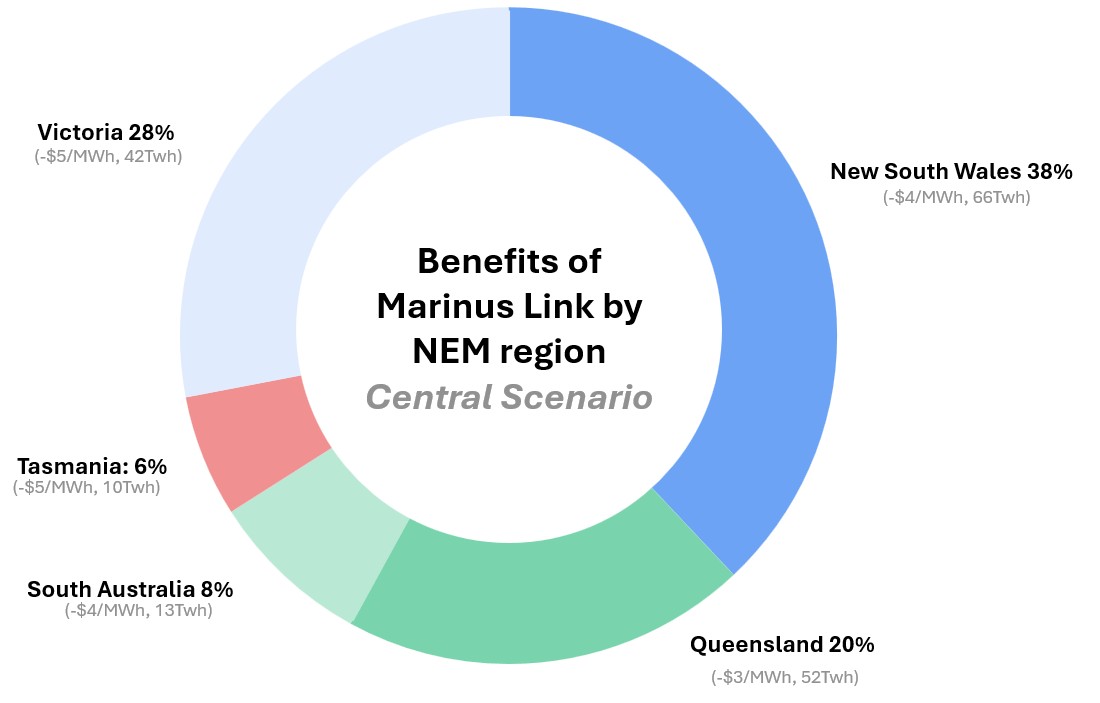
An October 2024 Australian Energy Market Commission
Rule Change allowed governments to negotiate cost allocations for projects crossing state borders. Under this new framework it was agreed that
Tasmanian consumers will pay 27.6% and Victorians the remaining 72.4% of project costs. This revised allocation means Tasmanian consumers will pay four times more than the original model – though overall costs to consumers are lower thanks to Commonwealth financing.
For a typical Tasmanian household,
Marinus Link Stage 1 is expected to add roughly $47 per year to electricity bills. However, analysis based on the Tasmanian Government’s
Marinus Business Case suggests this cost may be as high as $170.
4. Will there be consumer benefits?Given that consumers will pay for Marinus Link over the life of the project – and that total costs have more than doubled over the last 5 years – the obvious question is whether it will actually deliver lower energy prices.
The claim is that while transmission costs will definitely increase, this will be offset by lower wholesale prices. Because Tasmanian electricity prices are tied to the Victorian wholesale price, the logic goes like this:
- When Hydro Tasmania exports power, it can help lower peak prices in Victoria; and
- When mainland renewables are abundant and cheap (especially during the day) Tasmania can import that low-cost energy.
In theory, this exchange should reduce overall retail prices in both states.
The modelling here is complex and inherently uncertain, but the most recent (2025) analysis by
FTI Consulting forecasts annual consumer benefits of around $113 per typical household in Tasmania and $68 in Victoria based on an anticipated 10-15% decline in wholesale electricity prices.
Interestingly, FTI found that Marinus Link Stage 1 would still deliver net consumer benefits despite significant construction cost increases. This is largely due to a 75% drop in forecast hydrogen production in Tasmania over the next 20 years, given the poor economic return from using renewable energy for export hydrogen production.
5. What are the financial risks?
The latest modelling suggests that once commissioned, Marinus Link should deliver slightly cheaper energy prices for most consumers. What’s more certain, however, is that Tasmania’s major industrial users will face higher costs, contributing around $20 million extra per year in transmission fees. Although they’ll benefit from
increased supply and reliability.
It’s also worth remembering that forecasts of lower wholesale power prices depend on a wide range of assumptions that may not all hold true. Project costs, once approved, are effectively locked in and will be recovered from Tasmanian and Victorian consumers over the life of the project. The fact that costs are fixed and savings are uncertain poses a risk to consumers.
Broader considerations for Tasmania

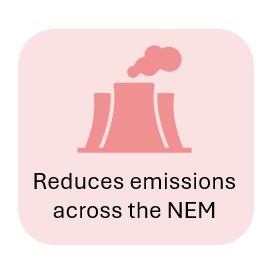
Marinus Link will help reduce emissions
- Marinus Link will provide ‘firming’ capacity to help balance wind and solar generation that would otherwise need backup from gas or long duration batteries. Without Marinus, an extra 4 terawatt hours of gas generation each year (around 2% of total NEM demand) would be needed in the 2030s.
- Marinus Link will also unlock new renewable energy projects in Tasmania, by creating a more dynamic, competitive market and more opportunities to sell electricity.

Marinus Link and renewable energy projects will boost our economy

Marinus Link will improve energy security and supply in Tasmania
- Marinus Link will strengthen Tasmania’s energy security and supply by expanding interconnection with the mainland and supporting renewable generation within the state.
- It will enable the decommissioning of the gas-fired Tamar Valley Power Station and allow Hydro Tasmania to maintain healthy dam storage levels.
- A larger supply of renewable power will help decarbonise existing industries and attract new clean energy businesses.

Marinus Link will help maximse the return for Hydro Tasmania
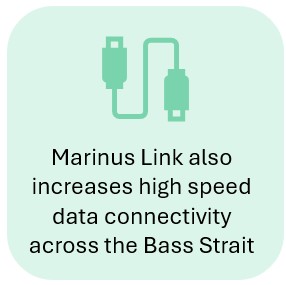
Marinus Link also increases high speed data connectivity across Bass Strait
- An important but often overlooked benefit is the inclusion of a high-capacity fibre-optic link between Tasmania and Victoria.
- Greater connectivity will support data-intensive industries and research collaboration and the adoption of technology.
So far so good... but what about the risks?


Disruption to the regions and communities
- Marinus Link and associated projects will attract significant investment in regional communities. But without collaborative regional planning, the influx of workers and construction activity could disrupt local communities, ‘crowd out’ local labour markets, and place extra pressure on housing and essential services.
- Best practice transition planning requires partnership with communities and a holistic approach informed by regional systems analysis. For example, the Tamar Valley Zero collaboration between The University of Tasmania and CSIRO’s Toward Net Zero Mission.

We might be 'backing the wrong horse'
- Energy systems are changing rapidly, and there’s uncertainty about which technologies will most cost-effectively meet future energy needs.
- Some argue that Australia’s future grid will be more decentralised by relying on local generation and storage rather than large-scale transmission. This would reduce the need for projects like Marinus Link.
- Over time, the NEM is likely to depend less on large-scale transmission, but for now, additional transmission is essential to meet medium-term emissions targets. Given the urgency of the climate crisis, we can’t risk waiting for emerging technology to mature.
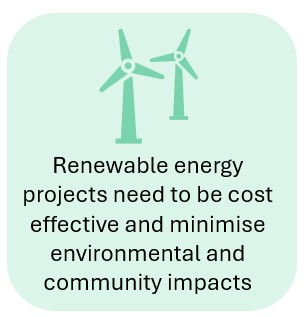
We may not be enabling the right projects
- Marinus will enable new renewable projects but the type and location of new projects will be critical to minimise environmental and community impacts.
- Working with communities to establish credible Renewable Energy Zones and fair benefit-sharing models will be key to building partnerships and trust.
Where to from here? Ensuring Tasmania benefits from Marinus Link
After almost a decade of planning, disruption and debate, the energy transition is finally gaining momentum – even in the face of growing political opposition. To make sure projects like Marinus Link deliver lasting benefits without driving up power prices, we need to address three key challenges: building community trust, better planning and coordination, and protecting consumers.
First, we need to move beyond a transactional approach to community engagement. Projects like Marinus Link can’t simply be built in communities; they must be built
with them. A regional, partnership-based approach – one that focuses on skills, training, housing, local services, and social procurement – can make sure the benefits of investment are shared and enduring.
Second, Tasmania needs smarter, more coordinated renewable energy planning. Tasmanians are rightly proud and protective of our landscapes and natural and cultural heritage. But both the climate crisis that the planet is facing and the energy transition means trade-offs are unavoidable. A revised Renewable Energy Zone framework can help strike the right balance between protecting community and environmental values and guiding development to areas close to existing transmission infrastructure. This will not only reduce conflict but also help attract investment and speed up approvals.
Finally, more must be done to protect consumers from financial risk, because the success of the energy transition depends on it. Big transmission projects like Marinus Link deliver both private benefits (through electricity supply) and public benefits (through emissions reduction). Yet the costs still mostly fall on consumers. Since
electricity bills are regressive, and Commonwealth taxation is relatively progressive, a fairer national cost-sharing model should be developed for major transmission projects. The Commonwealth’s concessional financing has already reduced some risk, but long-term equity requires structural reform.
The energy transition is urgent and necessary and requires both caution and coordination. Marinus Link, and other projects like it, are more than just cables and infrastructure: they can be catalysts for new industries, stronger regions, and fairer outcomes. But realising these benefits will depend on effective governance, genuine engagement, and careful planning and delivery. Above all, we need to make sure that projects like Marinus Link deliver long-term benefits to communities and leave a positive legacy for all Tasmanians.
The authors would like to give their thanks to colleagues for their review and feedback of this PIMBY.
Disclosure
Professor Richard Eccleston is a member of the Marinus Consumer Advisory Committee. However, this PIMBY contains the views of the authors and does not reflect the views of the Marinus Advisory Committee or Marinus Link.














